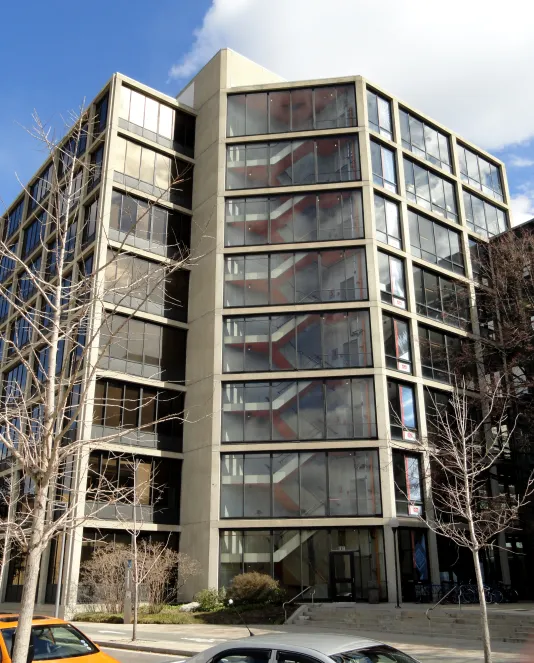Walter Netsch, Fairchild Buildings, 1971.
Fairchild Buildings, 1971

In developing the design for the Electrical Engineering and Research Laboratory, Walter Netsch sought to bring a department previously dispersed across the Institute into a cohesive whole.
Netsch situated the laboratory spaces along the same axis in Buildings 36 and 38, connecting them with a glass-bound corridor (the “knuckle,” as Netsch called it) that affords a transparent gateway from Vassar Street into the networked cluster of William Welles Bosworth's campus buildings (the corridor has since been reinforced and expanded to become the EG&G Education Center [Building 34], linking the complex to Building 24). Offices and classrooms extend out from the highly technical facilities, facing north and south so they are similarly in line with one another, but at a forty-five-degree angle from the laboratory axis.
The spatial organization of the volumes, the rectilinear geometries of the window panels, and the intersecting stairwells and other interior features are indices of “Field Theory,” a set of design principles developed by Netsch himself. The geometric system begins with the basic building block of the square. By rotating and layering the squares, Netsch produced complex plans dense with orthogonals, thematically unified by the iterative form.
Walter Netsch (1920–2008) was born in Chicago. After graduating from MIT with a degree in architecture in 1943, Netsch enlisted in the Army Corps of Engineers. In 1947, he joined the San Francisco office of Skidmore, Owings, and Merrill (SOM). He transferred to the Chicago office of SOM in 1951, where he became a partner and worked until his retirement in 1979. During the 1980s, he served as the parks commissioner for the city of Chicago.
Netsch is renowned for his institutional and academic projects completed at SOM, which include the US Air Force Academy Cadet Chapel, Colorado Springs; the Regenstein Library at the University of Chicago; Miami University Art Museum, Oxford, Ohio; the east wing of the Art Institute of Chicago; the master plan of the University of Illinois at Chicago; the Eye Clinic at Rush-Presbyterian-St. Luke’s Medical, Chicago; and the Baldwin Building at Mayo Clinic, Rochester, Minnesota.